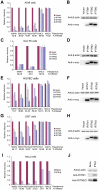Distinct patterns of IFITM-mediated restriction of filoviruses, SARS coronavirus, and influenza A virus
- PMID: 21253575
- PMCID: PMC3017121
- DOI: 10.1371/journal.ppat.1001258
Distinct patterns of IFITM-mediated restriction of filoviruses, SARS coronavirus, and influenza A virus
Abstract
Interferon-inducible transmembrane proteins 1, 2, and 3 (IFITM1, 2, and 3) are recently identified viral restriction factors that inhibit infection mediated by the influenza A virus (IAV) hemagglutinin (HA) protein. Here we show that IFITM proteins restricted infection mediated by the entry glycoproteins (GP(1,2)) of Marburg and Ebola filoviruses (MARV, EBOV). Consistent with these observations, interferon-β specifically restricted filovirus and IAV entry processes. IFITM proteins also inhibited replication of infectious MARV and EBOV. We observed distinct patterns of IFITM-mediated restriction: compared with IAV, the entry processes of MARV and EBOV were less restricted by IFITM3, but more restricted by IFITM1. Moreover, murine Ifitm5 and 6 did not restrict IAV, but efficiently inhibited filovirus entry. We further demonstrate that replication of infectious SARS coronavirus (SARS-CoV) and entry mediated by the SARS-CoV spike (S) protein are restricted by IFITM proteins. The profile of IFITM-mediated restriction of SARS-CoV was more similar to that of filoviruses than to IAV. Trypsin treatment of receptor-associated SARS-CoV pseudovirions, which bypasses their dependence on lysosomal cathepsin L, also bypassed IFITM-mediated restriction. However, IFITM proteins did not reduce cellular cathepsin activity or limit access of virions to acidic intracellular compartments. Our data indicate that IFITM-mediated restriction is localized to a late stage in the endocytic pathway. They further show that IFITM proteins differentially restrict the entry of a broad range of enveloped viruses, and modulate cellular tropism independently of viral receptor expression.
Conflict of interest statement
The authors have declared that no competing interests exist.
Figures







References
-
- Friedman RL, Manly SP, McMahon M, Kerr IM, Stark GR. Transcriptional and posttranscriptional regulation of interferon-induced gene expression in human cells. Cell. 1984;38:745–755. - PubMed
-
- Moffatt P, Gaumond MH, Salois P, Sellin K, Bessette MC, et al. Bril: a novel bone-specific modulator of mineralization. J Bone Miner Res. 2008;23:1497–1508. - PubMed
-
- Tanaka SS, Yamaguchi YL, Tsoi B, Lickert H, Tam PP. IFITM/Mil/fragilis family proteins IFITM1 and IFITM3 play distinct roles in mouse primordial germ cell homing and repulsion. Dev Cell. 2005;9:745–756. - PubMed
Publication types
MeSH terms
Substances
Grants and funding
LinkOut - more resources
Full Text Sources
Other Literature Sources
Medical
Molecular Biology Databases
Miscellaneous

